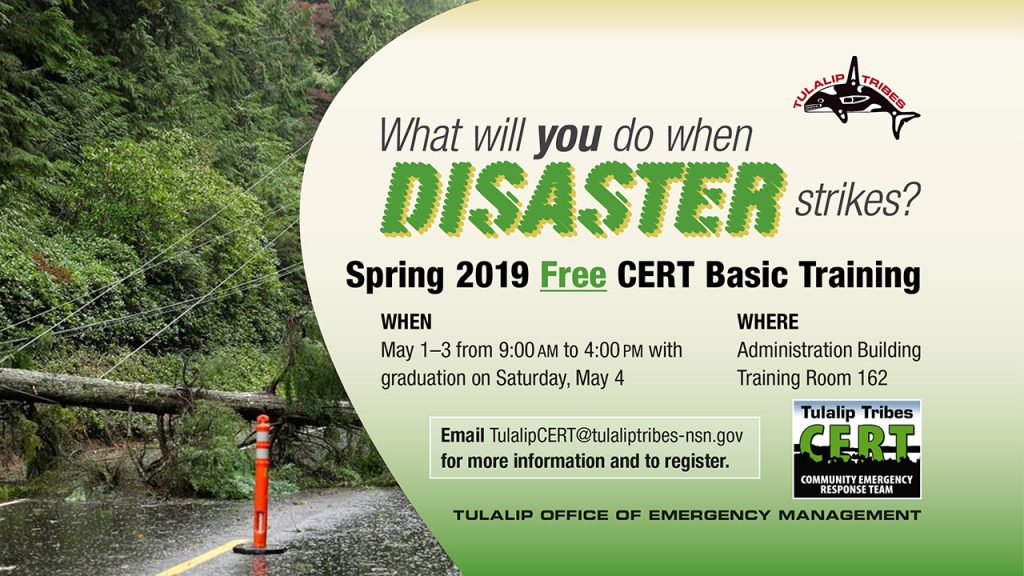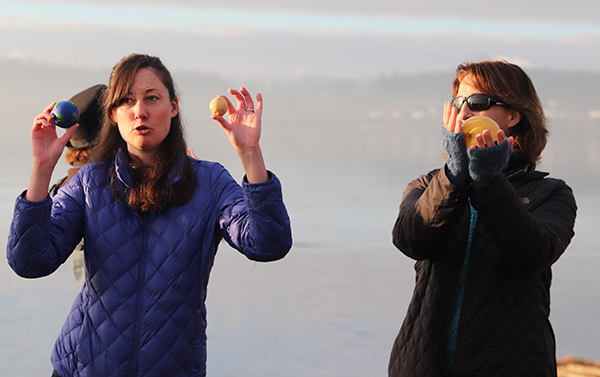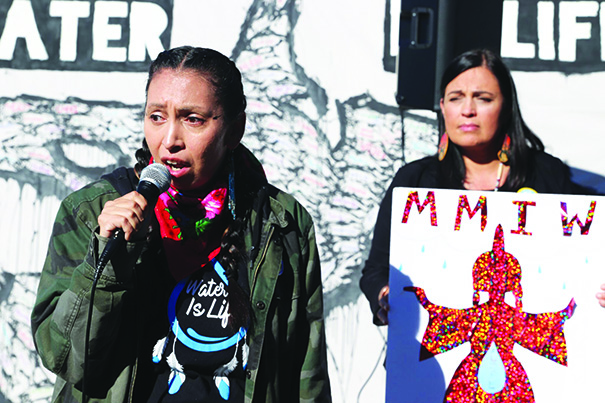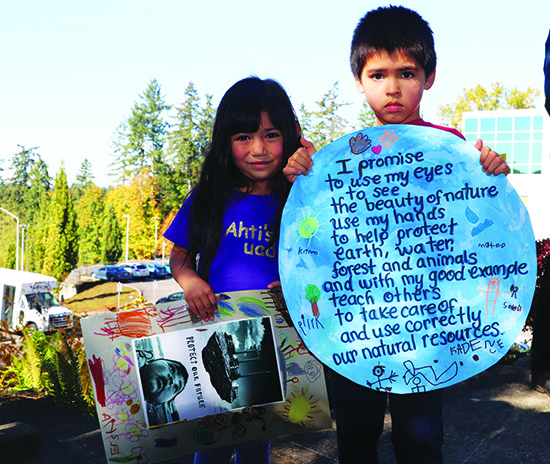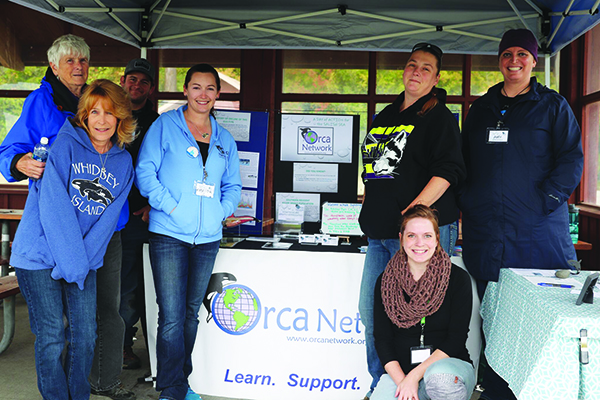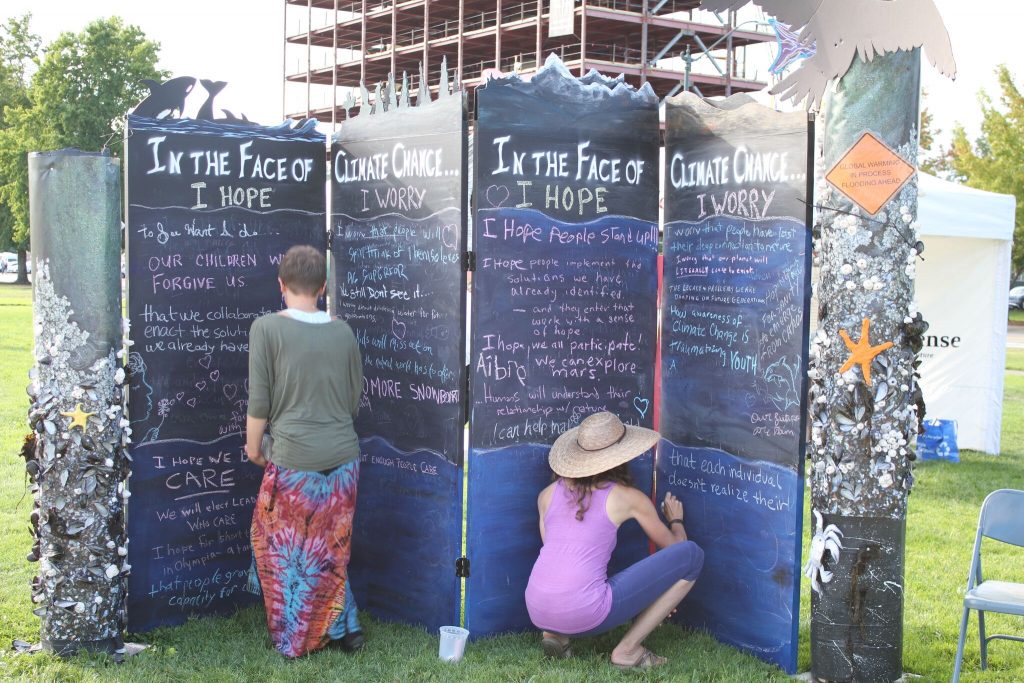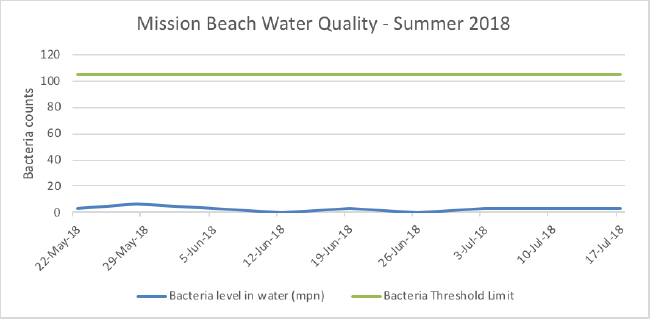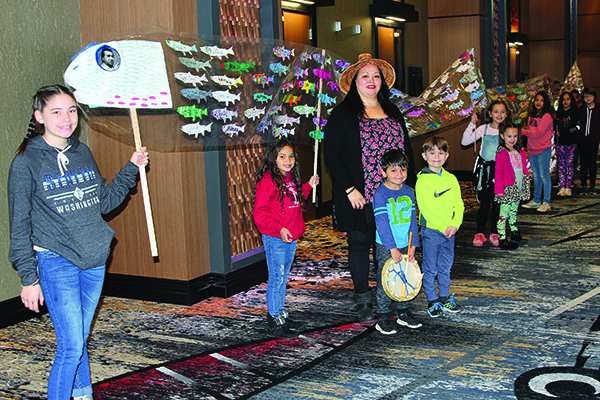Category: Environment
King tides and the impacts of rising sea levels

By Kalvin Valdillez; photos by Kalvin Valdillez and Ben Lubbers
Bright and early on the morning of January 25, a gathering of about thirty people met at Flintstone Park in Oak Harbor. Similar to Tulalip Bay, the waters of the Salish Sea travel into the inlet of Whidbey Island, providing a scenic view for the citizens of Island County. This morning in particular was gorgeous. While the sun emerged into the sky, fog slowly ascended from the water that was now approaching the paved boardwalk of the park. This was the event the locals came to witness, a king tide.
On the night of January 20, you may have caught a glimpse of the super blood wolf moon as the sun, earth and moon aligned perfectly. This rare lunar eclipse is also known as syzygy and causes a stronger gravitational pull and therefore, higher tides. At an estimated thirteen feet, the tide was highest at 8:28 a.m. in Oak Harbor that Friday morning. The long stretch of sand, rocks and driftwood that makes up the beach of Flintstone Park appeared to have vanished as large waves splashed against the coast.
“King tide is not a scientific term, it simply means higher than our normal everyday tides,” explained Bridget Trosin, of Washington Sea Grant, to the crowd. “In this area, we get king tides usually in November, December, January and February. One of the situations where we get a king tide is at a perigee tide. Basically that is when we orbit the sun and as the moon passes in that close section we get higher than high tides. As the moon is hugging the earth in its orbit, it’s bulging out our ocean waters.
“The other situation is when we have a nice alignment of the sun, earth and moon, that’s where we see a nice king tide from the pull from the sun and the pull from the moon as they’re compounding upon each other. And another event happens only on January 2. That’s as Earth is orbiting around the sun, we’re closer and that creates pull from the sun and makes our tides a little larger than normal. Any one of those situations can happen at the same time and each one gives the tide a directional pull.”
Now that the Oak Harborites acquired both a better understanding as well as a live visual of a king tide, Bridget requested that each member of the group download an app to their phones called MyCoast. The purpose of the app is to measure king tides at local shores by using user submitted photos. She then stressed that king tides are an important occurrence and the need to monitor them is crucial because they give us a glimpse into the future of what normal, or perhaps even low tides, might look like in a few decades due to sea-level rise.
Rising sea-level is a complex topic that will in time impact the entire planet. Many major cities across the world will experience severe flooding and in some extreme cases will be underwater completely. Because sea-level rise is so dynamic and there are several factors in play, it’s hard to determine exactly when specific areas will begin to see major impacts. However, the general consensus appears to be that sea-level will continue to rise at about its current rate until the middle of this century and then will actually accelerate at even a faster pace after that.
So what causes sea-level rise exactly and why should you be concerned? Since the Industrial Revolution in the 1800’s, the Earth has been heating up due to the burning of fossil fuels and the production of greenhouse gases. As the planet traps those emissions in its atmosphere, the warmer Earth gets. And as a direct result of global warming, the amount of water in the ocean is increasing because as water heats, it expands. Another large contributing factor to sea-level rise is the melting ice caps and ice sheets happening in both Greenland and Antarctica.
“Sea-level has risen eight or nine inches in the last hundred years and it’s accelerating,” says Phillip North, Tulalip Natural Resources Conservation Scientist. “Since global warming is happening faster than we expected, that means the water is getting warmer faster and expanding. We’re getting more sea-level rise than expected. Plus, the warmer ocean is melting the ice faster. Greenland is melting faster, Antarctica is melting faster, all the continental glaciers; everything’s melting faster than we expected. We’ll see a pretty steady progression up until the middle of the century and then it will start to speed up. It does seem that anytime anyone has ever said something like that, it’s happened sooner than expected and more than expected. We are already seeing it.”
Shortly after the King Tides event in Oak Harbor, and we’re talking merely a few hours, reports from major news sources were released. Alerts from the New York Times, BBC News and CNN began to pop-up onto people’s smartphones claiming that Greenland’s ice caps are indeed melting at an even much faster pace than predicted by scientists, environmentalist and conservationists.
The news was shocking to say the least and sent social media into a bit of a frenzy. The reports show ice caps in Greenland’s southwest region have been melting at least four times faster in the past decade than they have over previous centuries. Due to the combination of global warming paired with oscillation, a weather phenomenon that affects air temperature, Greenland’s ice caps are not only breaking off into large icebergs, which over time melts into the ocean, but are also beginning to thaw at the top of the glaciers which is causing ‘rivers’ of meltwater to pour into the ocean, and is subsequently melting more ice as it travels down the glaciers. Cities along the east coast of the United States will be the first to be affected and will see significant sea-level rise and are also now susceptible to more hurricanes.
Northwest tribal nations have been anticipating a rise in water for at least a few generations now. As coastal communities, Salish tribes are one the first to feel and witness the effects of sea-level rise. As you may recall, the Quinault tribe is currently in the early process of relocating both of their entire villages of Taholah and Queets because rising sea-level and high tides have already begun to flood the communities.
As sea-level rises, it has the potential to change entire landscapes. In a report released in the summer of 2018, the Projected Sea Level Rise for Washington State, evidence shows that because of the Juan de Fuca tectonic plate, many Puget Sound communities are currently sinking while Neah Bay’s land is actually rising.
In addition to inundation and landform change, another huge impact sea-level rise will have on tribal communities is habitat loss, reducing marshes, mudflats and intertidal habitats. Habitat loss can cause significant changes to the food chain and as Phillip explains, this happens due to the erosion of coastlines.
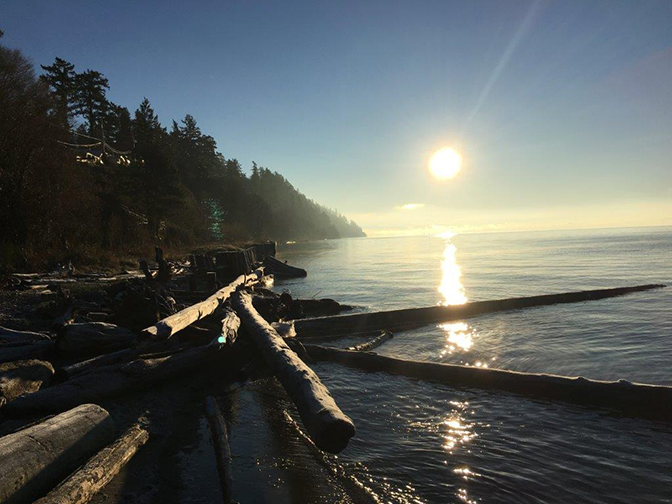
“One thing we are studying in Tulalip is our outer coast,” he states. “Because as sea-level rises, a couple things will happen. One, the water will be at base more often and it’s the water at the base of the bluff that erodes the bluff more than anything else. But also because it will be higher than the storms that are coming in. When storms come in, you have the distance over open water that the winds are blowing, the greater the distance the bigger the waves. But also the deeper the water, the less those waves are dragging on the bottom of the ocean floor and losing energy. So the deeper the water is, those bigger waves will come further in and hit the bluff more often. So you end up with faster erosion. As it erodes faster, that means that all the material is coming down faster.
“That material is what makes up the intertidal habitat. So how will the system deal with that, that’s another important question. That’s where all the clam beds, juvenile crab are and that’s where all the juvenile salmon and forage fish hang out. The dynamics of the energy of the waves on the beach sorts all that material, so you end up with patches of fine sand and gravel. All of those different patches are different type of habitat, so if you change the energy on the beach, those things all change. Those changes of energy change the habitat. Most of the detrital food chain are not eating the grass and seaweed directly but they’re eating it when it dies and starts to decay – that’s the base of a food chain. The way the detrital material gets distributed changes the habitat for juvenile crab, juvenile salmon, forage fish and all those organisms that live in those areas.”
Unfortunately, sea-level rise is inevitable. Yes, you read that correctly. In time, which is proving to be closer than we thought, all of the ice caps will melt and the world’s water to land ration will increase. How much it will increase and when is still yet to be determined but if the recent news of Greenland’s ice caps are any indication, scientists are predicting by the year 2100, cities around the globe can see anywhere from three to ten feet of sea-level rise. And although the east coast will probably see the effects on a larger scale, the entire west coast along the Cascadia subduction zone could be pushed back, making many current coastal cities uninhabitable. Researchers are hoping communities can look at these statistics and estimations to plan for relocation if need be and to prepare for a series of natural disasters such as extreme floods, storms and hurricanes that could result from sea-level rise.
“Get involved in your communities,” urges Bridget. “Let your planning commissioner know that this is something that you are concerned about, this is something we need to get on board with and make a priority. This is something that is extremely important to the resilience of your community.”
Please visit www.WAcoastalnetwork.com to view the most recent reports and projections of sea-level rise in Washington. And be sure to check out the National Oceanic and Atmospheric Administration Sea-Level Rise Viewer at www.coast.noaa.gov/slr/ to see how sea-level rise, of up to ten feet, can impact your communities, as well as for additional information.
Our treaties are the last line of defense
Tulalip Tribes educates community on Treaty Rights

By Kalvin Valdillez, Tulalip News
If you’re an avid Instagram user, and let’s face it most of us are, chances are you’ve stumbled across somebody’s profile that is filled with gorgeous photos of mountain ranges, waterfalls, beaches and tall evergreens. Every day, more and more people are exploring the beautiful Pacific Northwest, hiking hidden trails in search of breathtaking views and secret camping grounds.
A 2016 study, conducted by the Washington State Recreation and Conservation Office, reported that outdoor recreation generated over twenty billion dollars in this state alone. According to the U.S. Department of Commerce, outdoor recreation is a three-hundred-billion-dollar industry and is continuing to grow exponentially. And while it’s important to disconnect, inhale fresh air, enjoy scenery and experience the great outdoors, it’s equally important to remember that this land is sacred and has strong spiritual ties to the original caretakers of this region, who have lived off its resources since time immemorial.
Let’s use the power of imagination to travel back about two-hundred years or so. You’re a young Coast Salish hunter who has been tasked to provide food for your family and village. After many years of cultural teachings, you’re finally ready to head into the woods to get your first elk.
While you’re trekking up to the mountains, you recall all of the stories about elk roaming about in abundance in an area your family has hunted for generations. But you arrive only to see that there are hundreds of people hanging out, sleeping beneath the stars and enjoying themselves in a not-so-quiet manner. Because of all the people and constant foot traffic, there isn’t an elk in sight. So, you decide to try nearby areas to see if the elk have migrated, but instead you’re met with more people. Now you face the dilemma of providing another source of sustenance for your people, who depend on that meat for the upcoming winter months.
Although crowded hunting grounds weren’t an issue two hundred years ago, you can see how big of an impact it would’ve had on tribal villages. When the Coast Salish people signed their treaty one hundred and sixty-four years ago, they kept the right to hunt and harvest on the same lands their ancestors had since the beginning of time.
Fast forward to the summer of 2018. A story was released by a popular local radio broadcast, KUOW, with the headline reading, ‘Seattle Hikers: You may be trampling on tribal treaty rights.’ Within the article, Tulalip Natural Resources Fish and Wildlife Director, Jason Gobin, shared a similar story but in modern time, claiming that many outdoor adventurers are showing a total disregard to the tribe’s ancestral lands. He expressed that due to over congestion, the areas for tribal members to conduct their spiritual work, whether it be hunting, gathering cedar or harvesting huckleberries, has decreased substantially since the signing of the Point Elliot Treaty of 1855.
The story spread like wildfire across Facebook and Twitter as people shared the link, voicing both their support and concern. Over the course of a few months, the article inspired several outdoor recreational organizations and non-profit conservation groups to reach out to the tribe in an effort to learn more about tribal sovereignty. Because of the inquires, the Tulalip Natural Resources department hosted a daylong event for local non-governmental organizations to learn about treaty rights and the history of the Tulalip Tribes.
On the morning of January 9, around thirty individuals from recreational and conservation groups gathered at the Hibulb Cultural Center to begin the day with a tour of the museum. While having fun with the interactive displays, the group gained a basic understanding of tribal lifeways.
“It was a very powerful cultural exhibit, I learned so much I didn’t know before,” expressed Erika Lundahl of the outdoors publishing company, Mountaineers Books. “Particularly about the woolly dogs and also to see the special relationship the people share with the salmon in the area, as well as the weaving and the residential schools. It was powerful to hear first person accounts, it’s a lot to take in. There were things I’ve heard before, but getting a chance to hear the full story is something we all need to look at very closely to get an understanding of the impacts of generational trauma.”
The group then journeyed across the reservation and made their way to the Tulalip Administration building. In conference room 162, Natural Resources’ Environmental Liaison, Ryan Miller, spoke passionately about protecting the treaty rights his ancestors fought to keep.

“Treaty rights are an inherent right,” he explained. “Treaty rights were not given to tribes, it’s a common misconception that the government gives Native Peoples special rights. That’s the exact opposite of how it works. Tribes are sovereign nations, they give up rights and they retain rights. Treaty rights are rights that are not given up by tribes and they’re upheld by the federal government as part of their trust relationship with the treaty tribes. The tribes right to self-govern is the supreme law of the land. It’s woven into the U.S. constitution as well as many legal decisions and legislative articles. The constitution says, congress has the power to make treaties with sovereign nations and that treaties are the supreme law of the land.
“We all love the Pacific Northwest,” he continues. “Other people love it here too and they keep coming back, it’s really getting aggravating. I’m not talking about one person going out and hiking. That’s not the issue. What we’re concerned about, just like the population increasing, is that those people are coming here for what we all love to do, get out into nature. They want to see all those places that you love and I love, that I have a spiritual connection to. We have to figure out a way that we can provide that for people in a way that protects not only the inherent rights of tribes but the resources, so all of us can enjoy it.”
Libby Nelson, Natural Resources Senior Environmental Policy Analyst, gave the group an in depth look at the Point Elliot Treaty. During her presentation, she familiarized the participants with the term, ‘usual and accustomed grounds’. She also touched on the Boldt Decision and spoke of the Tulalip’s current co-stewardship with the U.S. Forestry department, which dedicated an area solely for spiritual use such as berry picking and the annual mountain camp for tribal youth during the summertime.
Natural Resources Special Projects Manager, Patti Gobin, shared a personal and moving story about her grandma, Celum Young, who was a first generation Tulalip boarding school student. As she shared her grandmother’s painful experiences, she quickly followed with a heartwarming story of Celum, depicting her as a woman full of love who struggled loving herself. Because of years of forced assimilation, Celum endured physical abuse for speaking her language and practicing her traditions while at the boarding school. And as a direct result from the boarding schools, Patti admitted that her grandmother never spoke Lushootseed or taught the language to her children and grandchildren, in fear that they would be punished just as she was.

Native children who were around Celum’s age also experienced these atrocities at the boarding schools. Indigenous languages slowly began to slip away from their respective tribal communities. It wasn’t until recently that the language saw a major revitalization within the Tulalip community. Patti shared all this information, weaving together tales of happiness during dark times, to paint a picture that showcases how the trauma from the boarding schools trickled down generation after generation.
Patti then asked the group to help honor tribal treaties, now that they are equipped with more knowledge and understanding of treaty rights and the tribal experience. She suggested signage depicting the tribe’s history as well as murals, such as the ones that will be displayed shortly in Skykomish and the San Juan Islands.
“You don’t have to tell the intimate story of the Stu-hubs people,” she stated. “You can simply begin with the most general knowledge, that there are Indian tribes in the area and we will respect their treaty rights.”
At the end of the presentations, Ryan handed out a list of principals to the recreationalists and conservationists, stating that the tribe wants to be included in any project proposals and to build strong relationships with each organization. He urged them to bring the principals back to their team and discuss and modify the list to meet their mission and values.
“Protection of treaty rights protects endangered species and habitat for all of Washington citizens, not just for tribes,” he said. “All the places that you love, all the species you care about, the orca, the salmon; our treaties are the last line of defense. When our state’s governor was telling the Trump administration that they couldn’t drill for oil off of our coast, he said it would be a violation of tribal treaty rights. We’re the last vanguard, help us protect it. Treaties are the supreme law of the land. They’re living documents and they have as much importance today, to us as Indian People, and they should to you as Washington citizens, as they did the day they were signed.”
The Tulalip Natural Resources Department plans on hosting several more Treaty Rights events like this throughout the year, tailoring their presentations to groups such as environmentalists and governmental entities. For more information, please contact Natural Resources at (360) 716-4480.
Related Articles:
The Treaty of Point Elliott: A living document
Tulalip prepares for Treaty Days
Tulalip youth exercise treaty rights, learn hunting safety
New colonizer in chief, same fight to protect our treaty rights
Tulalip educates community on habitat restoration and treaty rights
Point Elliott Treaty, 159 years later
Tulalip Tribes stewardship recognized by the Harvard Project
Pacific Northwest Tribes unite to protect and defend salmon
Tulalip Tribes stewardship recognized by the Harvard Project
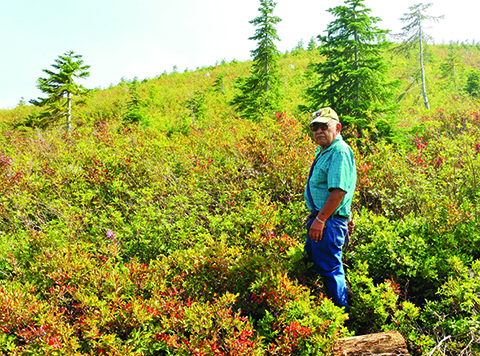
By Micheal Rios, Tulalip News
The Harvard Project’s Honoring Nations program has announced the selection of 18 semifinalists for the 2018 Honoring Nations awards. Among those selections are a variety of outstanding programs exemplifying self-governance and resource management, which includes the Tulalip Tribes ongoing demonstration of sovereignty through stewardship.
Honoring Nations identifies, celebrates and shares excellence in Native American tribal governance. At the heart of Honoring Nations are the principles that tribes themselves hold the key to generating social, political, and economic prosperity and that self-governance plays a crucial role in building and sustaining strong, healthy tribal nations
Since 1999, Honoring Nations has endeavored to spotlight successful governmental programs across Indian Country. This year’s applications included nearly 70 outstanding tribal programs representing 51 tribes. Of these, 18 were selected as semifinalists. These programs have demonstrated incredible impact in their communities, evidenced by their effectiveness, significance to sovereignty, cultural relevance, transferability, and sustainability – the criteria by which Honoring Nations assesses applicant programs.*
“Each year we are blessed with the gifts of Indigenous peoples’ resilience and perseverance reflected in their response to the challenges our people and nations face. They rise to the same levels as our forefathers did in their time to define the inheritance of the next generation,” stated Regis Pecos, Chairman of the Honoring Nations Board of Governors. “We are proud to share their wisdom and their vision.”
swədaʔx̌ali: Sovereignty through Stewardship”
Tribal communities in the Pacific Northwest have long-standing relationships to ancestral lands now managed by federal land management agencies. Generally speaking, during the centuries before colonial expansion, Indigenous peoples were profoundly connected with their natural surroundings. These cultures approached the natural world with an attitude of reverence and stewardship rather than dominion. In recent years, federal and state governments have increasingly recognized tribal rights to cultural resources on public lands and to participate in their management.
In the summer of 2009, three Tulalip staff accompanied the Skykomish District Ranger to a remote high elevation area of the Mt. Baker-Snoqualmie National Forest (MBS). This 1,280-acre area located 5,000 feet up in the mountainous highlands is now referred to as swədaʔx̌ali, a Coast Salish Lushootseed word for ‘Place of Mountain Huckleberries’.
“Over the last seven years, since the area’s formal designation, Tulalip has guided the management of this special area based on tribal values and ecological knowledge, and in direct support of the treaty, cultural, spiritual, subsistence and educational needs of our membership and our future generations,” explained Libby Nelson, Senior Environmental Policy Analyst for Tulalip’s Treaty Rights Office. “For example, rather than allowing continued encroachment of conifers that would eventually shade out huckleberries and other associated plants, Tulalip staff will remove many of them to stall natural succession in certain areas at swədaʔx̌ali. This will allow us to maintain productive berry fields and other cultural plants of importance, and enhance habitat for wildife that forage in open meadows.
“The swədaʔx̌ali co-management area did not happen easily or overnight,” continued Libby. “Instead, it was the result of a committed and sustained effort initiated by Tulalip to get the attention of our federal trustee, the U.S. Forest Service. Dialogue over three years culminated in the signing of the first tribal Memorandum of Agreement (MOA) on the Mt. Baker-Snoqualmie National Forest in 2007. As our relationship with the Forest Service grew under our MOA, so too did the breadth of projects undertaken.”

Tulalip Mountain Camp began in 2015, providing an annual weeklong, overnight natural resources and culture camp for middle-school tribal youth at σωəδαʔξ̌αλι This outdoor program seeks to connect youth to nature in a remote setting, teach them about their ancestral lands in the mountains, and engage directly with elders and our natural resources staff in huckleberry enhancement. This camp program has had a very positive impact on youth participants, as measured by camper surveys, feedback from families, and the significant number of return campers each year.
This initiative at swədaʔx̌ali is not only relevant to Tulalip culture, but is designed specifically to help sustain it. Continuation of tribal lifeways is dependent on having the resources that support these lifeways, access to them, and opportunities to transfer tribal knowledge and traditions to our youth. The 1,280-acre mountain area that constitutes σωəδαʔξ̌αλι, offers not only a diversity of habitats, plants and animals, but also remoteness, solitude and a relatively pristine environment needed for many cultural activities.
“We view our MOA and our work at swədaʔx̌ali as a strategic and dynamic government-to-government collaboration, with benefits directly proportional to the time and resources we invest in it,” reflected Libby. “The swədaʔx̌ali co-stewardship area most benefits Tulalip by providing an area for treaty gathering of high elevation resources, and for huckleberries in particular. It’s a place for our membership to connect to their ancestral mountain lands in a quiet, pristine, private setting, that is accessible to elders.”
The Harvard Project selected Tulalip’s ongoing stewardship of swədaʔx̌ali as a semifinalist for the 2018 Honoring Nations awards. As such, Tulalip’s commitment to stewardship is an active exercise in self-determination and implementing effective solutions to common governmental challenges in the areas of environmental research and resource management.
“Every day, tribal nations are solving complex issues in meaningful and effective way,” stated Director of Honoring Nations, Megan Hill. “Their work is inspiring, and holds examples for other governments, Native and non-native, to learn from.”
*Source: Honoring Nations press release, 3/28/2018
Yes on I-1631
By Kalvin Valdillez, Tulalip News
On a sunny autumn afternoon, a gathering was held outside of the Western States Petroleum Association building in Lacey, Washington on October 17. Many participants arrived wearing cedar hats and headbands and carrying traditional hand drums, as tribal members journeyed from around the state to show support of Initiative Measure No. 1631, an effort to charge pollution fees to large greenhouse gas emitters and conserve our natural resources for generations to come. As more and more participants arrived, they began to make signs to wave at local commuters who were taking a shortcut through an I-5 overpass. A number of small drum circles began to form and prayers were shared while they waited in anticipation for the I-1631 rally guest speakers to take the floor, including former Standing Rock Chairman, Dave Archambault and Quinault Indian Nation President, Fawn Sharp.
“Today we are here to raise awareness and to rally support around I-1631 right in front of the Western States Petroleum Association,” passionately expressed President Sharp. “They have sunk over twenty-two million dollars into their campaign to stop us but we are resilient, we are strong and we want to amplify our voice. We are confident that through our prayers and through the rich legacy of leadership throughout the ages, from the beginning of time to the end of time, we are going to be victorious on election day.”
As this year’s General Election date of November 6 draws nearer, it’s important to understand what I-1631 is and why it’s important for Northwest tribes. The initiative is a climate policy that imposes a fee on organizations that burn or sell fossil fuels, that includes motor vehicle fuel, natural gas and electricity. The measure is expected to generate over two-billion dollars within five fiscal years, beginning on January 1, 2020, and is set at fifteen dollars per metric ton of carbon content, or the carbon dioxide equivalent released from burning fossil fuels. This will increase by two dollars each year until 2035, putting the state on target to reach its 2035 and 2050 greenhouse gas reduction goals.
The monies generated from the carbon fee are prioritized as follows: 70% of carbon fees will go toward a new clean-energy infrastructure for Washington, utilizing clean, renewable energy, providing public transportation that uses cleaner fuels as well efficiency upgrades to homes and businesses to help save money on utilities; 25% of funds from the measure will go toward clean water and healthy forests, ensuring our forests are well taken care of and can protect the air quality, clean-up polluted lakes and rivers, increase the amount of drinking water and ensure cleaner water for salmon; and the remaining 5% will be invested into the local communities, preparing for any future problems that may arise due to climate change.

“I-1631 is a specific climate policy tribes’ gathered over the last year and a half,” says Fawn. “Quinault has been working on this initiative for well over two years and we’ve been working on climate policy for about twelve years. It was very clear to us that we’re not going to achieve climate policy in Olympia, it’s not going to happen in Washington D.C., but we were also confident that the average citizen understands the role of tribes as leaders.
If you look to Lummi at Cherry Point or Quinault fighting crude oil in Grays Harbor, the average citizen understands our treaties are the last line of defense to keep corporations out and from continuing to exploit our natural environment. We pulled all those resources together, the brain trust of Indian Country, our scientists, our lawyers, our tribal leaders and we adopted thirteen basic principles of climate policy that we knew were the minimum standards for us to effectively combat climate change.”
As the rally continued, tribal and community leaders from Tulalip, Quinault, Puyallup, Nisqually, Squaxin and several other sovereign nations shared their traditional songs as well as words of encouragement that got the crowd of over one-hundred I-1631 supporters hyped. Young Tulalip and Tsleil-Waututh Indigenous Activist, Cedar George-Parker, spoke to the youth about the importance of their voice and Earth-Feather Sovereign talked about MMIW (Missing & Murdered Indigenous Women), continuing to bring much needed awareness to the epidemic that is claiming the lives of our Native women. Dave Archambault journeyed from the Standing Rock Sioux Tribe to show his support of the initiative.
“For me, [I-1631] means the things that happened at Standing Rock lives on,” he says. “The effort that was put forth to protect Unci Maka, Mother Earth, wasn’t lost just because that one battle didn’t work out the way we wanted it to. The policy that fails us is consultation and 1631 is a way to address that and a way to assure that tribes have complicit consent when a project threatens their homelands or threatens their environment, threatens mankind or humanity. When tribes speak up, we will be heard and that’s transcends from Standing Rock and that’s what today means to me.”
I-1631 does in fact have a provision for the tribes of Washington state that requires any state agency to consult with tribes on any decisions that could directly affect the tribes, their land or their usual and accustomed fishing grounds. Projects that are funded or begin on tribal land without prior consultation will be forced to end upon request of the tribe. Keeping the tribe’s sovereignty at heart was the First American Project comprised of several tribal leaders and El Centro de la Raza, a Latino based organization that promotes unity amongst all races.
“The First American Project was originally founded when tribes organized to take out Slade Gordon and elect senator Maria Cantwell,” explains Fawn. “When it came time to organize for I-1631 we thought it would be a natural fit to revive something that worked so well for tribes in the past. We wanted not only to create space for tribal nations but also our partners like El Centro de la Raza who helped us during the fishing wars. It’s an exciting opportunity for us to join our communities that have worked effectively in the past. We view I-1631 as the first issue we are going to take up. We understand that there are many issues of our generation like immigration that we can partner with El Centro because I think tribal nations have something to say about immigration and separating children from families.”
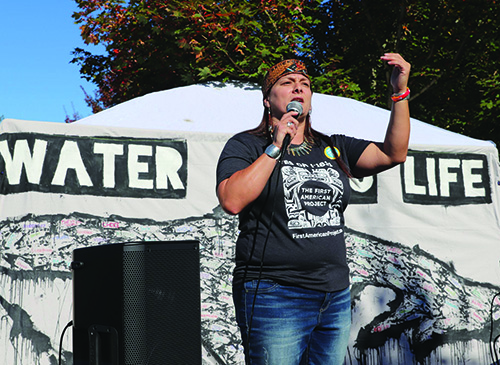
Tulalip tribal member and First American Project Board Member, Theresa Sheldon, took up emcee duties during the rally. She is also the project’s Campaign Chairwomen and has been tasked with informing and educating Native Peoples on why the initiative is important.
“It’s important for us because we’re the first ones who feel it,” Theresa states. “Native Peoples are like the canary birds in the coalmines, we’re the first ones to show signs of it not being safe. We’re already seeing that; we’re seeing that in gathering our cedar, gathering our huckleberries, we’re seeing the change in the seasons happen and the change in our plants. Sea level rise is already impacting our nations, look at Taholah, Queets and Hoh who have to relocate. They’re the first ones on the ocean so it’s already impacting them. Tulalip Tribes just did our climate change flood levels and in fifty years we’re looking at a lot of different areas of our reservation that potentially could be under water. That’s scary to think about, that will be during my lifetime so I’ll probably see that.
“It’s also important for Natives because carbon is what warms our water,” she continues. “Carbon pollution warms our Puget Sound and our rivers and that’s what’s impacting our fish. That results in not being able to have our fish, crab, our traditional foods. And once it’s gone, there’s no coming back. All the studies have shown that we’re the ones who can make the change, this generation has to make monumental changes. It has to be radical, it has to be fierce and intense changes, it can’t be to just stop using straws.”
Studies show that climate change is real and is currently happening at an alarming rate. If we continue to emit pollution into the environment, scientists predict that in a hundred years the world will frequently experience deadly, extreme heatwaves for days at a time. And if you think about it, one-hundred years isn’t that far away and the heatwaves are going to be something your great-great-grandchildren will have to live through. As Theresa pointed out, tribal lifeways are already being threatened by climate change, namely the Quinault Indian Nation’s villages of Taholah and Queets.
“This is important as Quinault tribal leader because we are right now facing an emergency situation where I’m having to relocate two of our villages to higher ground, the villages of Taholah and Queets,” says Fawn. “In my tenure as President of the Quinault Nation, I’ve seen it first hand, it’s created an unreal sense of urgency for me and we’re going to continue to fight this until we achieve those policies that we know are minimally necessary for us to defend ourselves and advance our future.”
If voters pass I-1631, the initiative will create over 40,000 jobs in the clean energy field, developing and maintaining renewable energy resources such as wind turbines. A number of big name supporters including Bill Gates and Pearl Jam recently expressed that they are in favor of the measure. And organizations such as Microsoft, Expedia, Union of Concerned Scientists and the American Lung Association are funding the initiative.
On the other side of the coin, Western States Petroleum has dug deep into their pockets and raised over twenty-five million dollars to run a slew of misleading TV ads against I-1631 claiming that the fee is ‘unfair’ to big oil. The opposition also wants you to believe that a large amount of companies are exempt from the fee, which is true to a degree if they are referring to coal burning factories or power plants that have been legally bound to close no later than 2025.
A real concern for undecided voters is that the cost of gasoline, electricity and natural gas is expected to rise as a result of the companies’ obligation to pay the carbon fee. However, funds raised from the fee will actually help Washingtonians transition into more of a clean energy lifestyle by utilizing renewable energy resources such as solar and wind power, so we’re not dependent on companies who are harming the environment.
“The power of our tribal communities is so remarkable and I firmly believe that when we come together, no matter what the issue, we’re unstoppable,” expresses Fawn. “When you look at this last year, we were victorious on the culverts case, we were victorious on eleven different treaty conflicts with the state of Washington. At any time, anyone or anything tries to attack us and we come together, we’re quite successful.
“We envision a clean, healthy future. A prosperous future where renewable energy, new technologies and new economies are going to be developed and you’re going to see an explosion of growth in Indian Country. The one thing I would like to tell the voters is to get out there and vote. If you’re not registered, register [by October 29] and make sure your voice counts on November 6.”
For more information, please visit www.YesOn1631.org
Protecting our Salish Sea, the salmon and the southern resident orcas

By Kalvin Valdillez, Tulalip news
The traditional Tulalip story, the Seal Hunting Brothers told by Martha Lamont, is the story of two young Tulalip men who lived at Priest Point. The brothers would travel the Salish Sea hunting for seals, salmon and shellfish for the entire community. The brothers prepared and delivered plates of fresh seafood to the elders as well as to their sister and her family, informing their sister to save some food for her husband, who was a carver and often away from home. The sister, however, disregarded her brother’s advice and distributed her husband’s share amongst herself and her children.
When the carver returned home, there was no food in sight. He asked his wife if her brothers dropped off any food for the family while he was away, to which she replied no. Upset at this news, the carver constructed a lifelike seal carved from cedar and enchanted the structure with magic to trick the brothers. They took the bait. The brothers harpooned the cedar seal statue while on a hunt and were pulled deep into the ocean only to wash ashore days later, miles away from home. Realizing what their brother-in-law did, they began their long journey home where they were presumed to be dead.
Upon their return to Tulalip, the brothers shared their story with their family and decided because of the complexities of the situation, they should live away from the tribe. They chose to begin a new life upon the waters that long provided food for their community, the Salish Sea, and became killer whales. Their descendants are said to be the southern resident orcas that still frequent the Salish Sea waters searching for Chinook salmon.
Similar stories of the brothers are shared within Indigenous communities all along the waterways of the Salish Sea, comprised of the waters now known as the Strait of Juan de Fuca, Puget Sound and Strait of Georgia. As the story goes, the brothers chose to stay close to home and often provided seafood to the Coast Salish peoples in times of famine. The story teaches many important values of the Northwest tribes as well as explains our strong connection with the orca, who is often honored within the culture through stories and artwork.
The southern resident orcas are intelligent, sociable mammals who share a lot of the same values and traditions of the Coast Salish people. For instance, the southern resident orcas are known to perform ceremonial practices during social gatherings when all three pods, J, K and L, meet up, which is known as a superpod. The most recent superpod was held last week in the waters near Vancouver Island where footage of the gathering was caught by the locals and tourists of Victoria, British Columbia. The orcas also travel with the same pod for their entire life, relying on each other’s strengths within a multi-generational family, much like many Native communities.
Another similar interest we share with the orcas is our love for salmon. The importance of salmon to Coast Salish people has been well documented over the years and is integral to each tribe’s way of life. The tribes of Washington State were guaranteed fishing rights when signing the treaties with the United States Government in exchange for land. Since the Fish Wars, the Boldt Decision, and even up until today, tribes exercising that right have been met with a number of challenges.
Over recent years, the salmon population has seen a dramatic decline. A number of manmade dams and blocked culverts are preventing salmon from swimming upstream during spawning season and less salmon are returning each year. In fact, many tribes opted not to fish this season in hopes more salmon will spawn and increase salmon population. Pollution remains another constant concern for aquatic life in the Salish Sea with chemicals and waste pouring into the waters from storm water runoff and local ferries traveling the straits. The lack of salmon has caused tribes to stray from their traditional diets and therefore more tribal members are faced with health concerns.
The same can be said about the southern resident orcas. The lack of salmon and polluted waterways caused some serious health concerns for the whales including reproduction. The orcas are crying out for help. This past summer’s heartbreaking story about southern resident orca, Tahlequah (J35), carrying her dead newborn calf for seventeen days on a ‘tour of grief’ caused tears across the entire nation. And the recent proclamation of Scarlet’s (J50) death is further evidence that we need to take immediate action.
In the sixties and seventies, a third of the southern resident population were hunted at a young age and held captive at marine life amusement parks like SeaWorld. Orcas often live well past their eighties, but unfortunately all but one of the orcas captured have died at a young age. Tokitae, the last remaining poached orca, resides at the Miami Seaquarium and the Lummi tribe has been fighting for years to return the whale to the Salish Sea.
As a result of starvation, theme park poachings and pollution, the southern resident orcas were placed on the endangered species list in 2005 after a significant drop in population of nearly twenty orcas over the course of a decade. Since then, the number of orcas has been steadily declining. With the passing of Scarlet, only seventy-four orcas remain.
Because of the recent news, Washington State Governor Jay Inslee established a southern resident orca task force whose main focus is orca protection and recovery. Members of the task force include representatives from Washington state, a handful of tribes and the National Oceanic and Atmospheric Administration (NOAA). The passing of both J35’s calf and J50 is opening up an important conversation about respecting Mother Earth and taking care of the environment. More and more citizens are participating at rallies in support of the salmon and orca such as the Festival of the Steh-Chass in Olympia and the Salmon Celebration in Seattle. The most recent effort united over thirty communities throughout Washington state and British Columbia.
September 15 marked International Coastal Cleanup day, where seaside communities participated in clearing their local beaches of any trash or harmful products. Communities of the Salish Sea, along with a number of non-profits like 350 and the Orca Network, banned together to tailor International Coastal Cleanup day to the Pacific Northwest communities by organizing Salish Sea Day of Action, which provides information and resources about the state of the Salish Sea, the southern resident orcas and the salmon habitat at the cleanup events.
Citizens of Tacoma, Port Townsend, Edmonds, Shoreline, Bellingham, Lopez Island and Mount Vernon, as well as Victoria and Vancouver, gathered in their respective hometowns to clean the beaches, offer prayer, honor and thank the water for its plentiful resources on the rainy Saturday morning.
“Today is a day of action for the Salish Sea and we wanted to join in,” says Amanda Colbert of the Orca Network at the Action for Orcas event in Mount Vernon. “It’s also International Costal Cleanup so there are quite a few events all up and down the coast with multiple organizations. Orca Network decided we wanted to be a part of this because, as you know, any trash, pesticides and chemicals that wind up in any of our rivers eventually leads to the ocean. I’ve run a beach cleanup once out here before and I just thought that this would be another wonderful opportunity to jump in and get the community on board.”
The Orca Network event attracted many participants and the sands of the Bayview State Park in Mount Vernon were trash free in no time. During the cleanup, attendees passionately spoke of protecting the environment and the southern resident orcas.
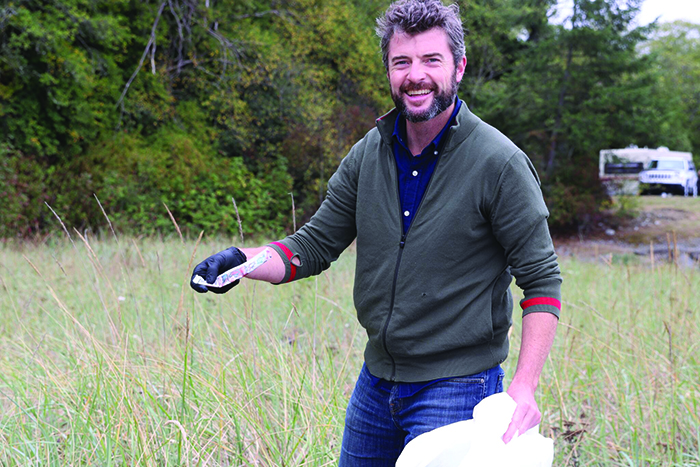
“The oceans are definitely in trouble,” says Ryan Rickerts of Bellingham. “Most of the planet is covered by water, it’s our source of everything. Coming here today is a way for me to connect and give back a little bit. The orcas are in real big trouble, so I wanted to be around likeminded people that care about the ocean, the orcas and wanted to do something to help. Hopefully we keep this up; good energy is building. With the orcas that have been dying, hopefully that creates a sense of urgency for people to get together. The Swinomish hosted the orca task force meeting a couple weeks ago and I think it’s good for people to come together to keep talking about it and try to find solutions. We have to take action and it helps to have conversations and get everybody at the same table because it’s going to take everyone.”
Tulalip tribal member and Water Protector, Kayah George, hosted a prayer service the day following Salish Sea Day of Action where she shared spiritual and cultural teachings about the water during Sunday worship at the Woodland Park Presbyterian Church.
“What concerns me about what’s happening in the Coast Salish Sea is the same thing that has been concerning my people for hundreds of years,” Kayah passionately expressed in a video leading up to Salish Sea Day of Action and her prayer service. “It is the disrespect. The utter and complete lack of respect for our brothers and sisters in the sea and for the sea itself. It’s not seen as a living thing; they see it as something that’s disposable.”
The number of supporters at the Salish Sea Day of Action events shows that people are beginning to listen to the calls for help by the beautiful coastal killer whales. And through a combined effort, we can all make a difference in protecting the orcas by restoring the salmon habitat, and that begins with the removal of dams, culvert repairs and environmental awareness.
“There are plenty of ways that people can start,” shares Amanda. “A lot of it is being focused on what you buy at the grocery stores. There are cleaner, greener products out there that are biodegradable. We have to move away from single use products. A lot of what was picked up here today was plastic wrappers, straws and cups that are only used once. So it’s helpful anytime anybody can pick up a water bottle or a green bag. If you don’t want to give up straws, there are companies making reusable metal or BPA-free plastic straws. What we treat our lawns with also has a huge impact. We get a lot of rain here so a lot of things end up in the storm drains. I’m thankful for all the volunteers that came out today and for the opportunity to reach and talk to people about our southern residents and what they’re going through.”
To stay up to date on the southern resident orcas, please visit www.OrcaNetwork.org or check out the Department of Ecology at www.ecology.wa.gov to find out more about the Orca Task Force, Salish Sea spills and cleanups, salmon recovery and upcoming meetings and events.
Festival of the Steh-Chass Celebrates Salmon Protection and Restoration

By Kalvin Valdillez, Tulalip News
Pre-colonization, the Port of Olympia was once a plentiful estuary that was occupied by the Steh-Chass people on Squaxin Island territory. Salmon swam in abundance through the inlet and there was no shortage of wildlife in the estuary, providing food for the Steh-Chass community comprised of a number of tribal members from Squaxin Island, Nisqually, Chehalis and Suquamish. The Salish Sea waters freely flowed from the Puget Sound through the estuary along the Deshutes River, ensuring nourishment for the people.
As time passed, the area eventually became the home to Washington State’s capital and in the 1950’s, the state built a dam on 5th Ave. The dam separated the lake from the Puget Sound, creating a reservoir used to reflect the Washington State capital building on its surface. The once bountiful estuary is now a decorative body of water known as Capital Lake where currently no native wildlife reside. Not to mention that nearly every spawning season since its construction, the dam has been home to a number of seals who pick off salmon attempting to swim upstream.
Billy Frank Jr. was a strong advocate for the removal of the dam. Salmon Defense, a non-profit established by the twenty Northwest Washington tribes, continues his vision today, years after his passing. And for nearly three decades, the Deschutes Estuary Restoration Team (DERT) has been fighting the same fight, actively working to reconnect the reservoir back to Puget Sound and restore the estuary.
Over Labor Day weekend, Salmon Defense and DERT teamed up, along with the Tulalip, Puyallup, Nisqually and Squaxin Island tribes, to host a festival celebrating Indigenous culture while honoring local tribes and the water in the name of salmon recovery and estuary restoration.
The first annual Festival of the Steh-Chass was held September 1, at Heritage Park in Olympia overlooking Capital Lake. The weather was sunny and clear and a stage was setup at the center of the park where the Washington State Capital was visible in its background. The start of the festival, however, began at the 5th Ave dam as tribal members and Olympia community members welcomed the canoe families of Squaxin Island, who pulled into the Port in traditional cedar canoes. The crowd then followed the canoe family as they sang the traditional songs of their people while walking through Heritage Park.
“What we wanted to do with this festival is create a space for Indian people to gather, talk, sing and celebrate Indian people and reawaken the Indigenous spirit of this area,” says Salmon Defense Director and Willie Frank III’s wife, Peggen Frank. “The Salmon Defense has been wanting to do something to raise awareness for the salmon, for the crucial state we’re in. The salmon are collapsing and it’s really scary. For me, as a tribal person, the reason why I’m fighting for the salmon is not only because of what [Billy Frank Jr.] taught me – and that’s when salmon are healthy, we’re healthy and without clean water we won’t survive – but the coastal people have a beautiful culture and the salmon are a vital piece of that culture.
“The tribes are so powerful here because of their treaty rights,” she continues. “That’s how Salmon Defense was created from the Northwest Washington treaty tribes to litigate, advocate and educate on behalf of Pacific Northwest salmon. When they put the dam in and created this pond, they destroyed two-hundred and fifty acres of salmon habitat. If we remove the dam and are able to start the restoration process, we’ll have both Coho and Chinook salmon. Those are the two main species that our resident orcas eat. If we’re not able to create, protect and enforce policies that save salmon, that enhance salmon restoration, that support tribal treaty rights, we’re not going to be able to save the orca.”
Information booths were stationed along the park’s walkway from organizations such as Northwest Treaty Tribes, Salmon Defense and DERT. Children got to enter the belly of a giant salmon, named Finn the Fish, and learn about the watershed habitat through traditional art that was painted on the inside of the fish.
“We came out today because anytime there’s an opportunity to join forces in protecting our water, I think it is absolutely our responsibility,” says Tulalip Tribal member, Theresa Sheldon. “I think it’s amazing to bring our young people together; we have to get our youth more involved because our youth’s voices are so powerful. When they’re fighting and protecting the Mother Earth and doing this justice for the environment, that will transcend boundaries and crosses over any politics and gets to the root core of who we are as Indigenous People.”
As the day progressed a number of talented Native American singers and artists took the stage, including Suquamish singer and WaterIsLife activist, Calina Lawrence, as well as singing trio, Thunderbirds Raised Her, who are a group of young sisters from Lummi. The crowd was moved by both acts as they sang about important issues in Native America like protecting the water and growing up on a reservation. The songs were in contemporary R&B fashion while incorporating elements such as hand drums and their traditional language into the music. Several other Native performers kept the crowd entertained throughout the day including Seattle hip hop artist Momentum X and the Indigenous Sisters Resistance group, as well as a fashion show by Indigenous Designer Abriel Johnny.
The festival’s headliner did not disappoint. Event goers rushed the stage as Native American rapper and advocate, Taboo from the Black Eyed Peas, began to perform an array of the hip hop group’s hits that had the crowd dancing.
About halfway through his set, Taboo asked the sound crew to cut the music so he could talk to the people about protecting our natural resources. He explained that he was so moved by the NODAPL movement that he postponed recording a new project and tour dates with the Black Eyed Peas to ‘go to Standing Rock to be with my people’, after receiving full support from bandmates. Taboo also spoke about the resiliency of Indigenous people before performing his MTV Video Music Award Nominee song, Stand Up/Stand N Rock.
Following Taboo, Willie Frank III took to the stage to close out the Festival of the Steh-Chass.
“As we talked about all day today, the message is to make this lake flow into our Puget sound, make it an estuary again and bring the salmon back to Capital Lake,” he passionately expressed. “It’s so good to see all these youth out here taking part in this, they are truly our next generation, they are our future. Our elders are the most important piece of our culture and now we have the youth coming up, and we’re going to educate them. We’re going to do what we need to do to protect our salmon, to protect our natural resources.
“The salmon defense was an idea from my late father, Billy Frank Jr., and it’s been four years since he’s passed. I know he’s looking down on us with a big smile shouting, ‘get rid of the damn dam!’ My hands go up to everybody who help put this together, it’s been a great day. We’re still here and we’re not going anywhere.”
Mission Beach Water Quality Mid-Summer 2018 Report
By Valerie Streeter, Tulalip Tirbes Natural Resources Dept.
For the past three years, WSU Beach Watchers volunteers have monitored the quality of water at Mission Beach each week during the summer months. Every Tuesday, you will see them dipping bottles into the water or monitoring the temperature and salinity. The volunteers drive the water samples up to the Tulalip Water Quality Lab, where Harvey Eastman analyzes the water samples for bacteria levels. The beach has been sampled nine (9) times this summer.
So far, this year has the lowest bacteria levels in the water when compared to 2016 and 2017. These levels are well below the threshold limit for swimming, which means that the water is clean! The graphs below show the average result from the three beach sampling stations for this year as well as the last two years. The green line shows the bacteria threshold limit (103 mpn/100mL) and the other line is the average amount of bacteria in the water at Mission Beach (not above 7 mpn/100mL for 2018). If bacterial levels are above the threshold limit, there are more chances for skin infections or gastrointestinal illness from too much pollution.
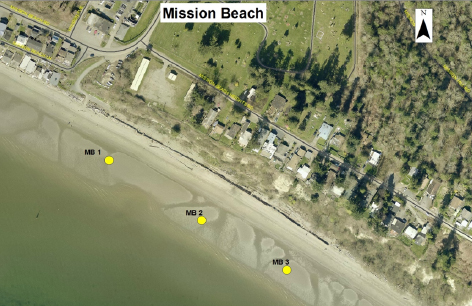
Pacific Northwest Tribes unite to protect and defend salmon
By Micheal Rios, Tulalip News
The life and legacy of Billy Frank Jr. was honored on March 19, as a dynamic group of tribal leaders and state representatives assembled for the Billy Frank Jr. Pacific Salmon Summit, held at the Orca Ballroom in the Tulalip Resort Casino. The goal was to continue the teachings of a fearless leader and historic visionary, while igniting others to carry the torch to advance and strengthen policies to protect and defend salmon and salmon habitat.
Billy Frank Jr., who died four years ago in May, committed his life to protecting his Nisqually people’s traditional way of life and to protecting the endangered salmon whose survival is the focus of tribal life. Beginning with his first arrest as a teenager in 1945 for “illegal” fishing on his beloved Nisqually River, he became a leader of a civil disobedience movement that insisted on the treaty rights (the right to fish in “usual and accustomed places”) guaranteed to Washington tribes more than a century before.
His activism ultimately led to the Supreme Court’s landmark Boldt Decision in 1974, affirming Native American treaty fishing rights. The Boldt Decision held that the government’s promise to secure the fisheries for the tribes was central to the treaty-making process, and allocates 50 percent of the annual catch to treaty tribes.
Pacific salmon have long played an essential role in the cultures and lives of the Indigenous People of the Pacific Northwest. Today, salmon and their precious habitat are in a critical state because of unchecked commercial fishing, waterway contamination, habitat destruction, net-pen farming, and road culverts that restrict fish habitat.
In order to ensure future generations can continue to practice their traditional ways of life, existing efforts to protect the salmon must be enhanced and strengthened. That is why the Billy Frank Jr. Pacific Salmon Summit was the perfect opportunity for tribal leaders, fishery managers, policy makers, state representatives, scientists, and the public to come together and discuss strategies for protecting salmon for the future.
The Pacific Salmon Summit opened with traditional drumming and prayers by the Tulalip Canoe Family. As the welcome song echoed through the Orca Ballroom, students from Quil Ceda Tulalip Elementary proudly displayed their banner created from hundreds of salmon cutouts they created during Billy Frank Jr. spirit week.
Speaking beneath a conference banner bearing Billy Frank Jr.’s portrait and the slogan, “The Truth Will Lead Us,” Quinault Indian Nation President, Fawn Sharp, gave the summit’s keynote address.
“I saw Billy as a historic visionary. He had this ability to go back to treaty time and had an incredible understanding of what those words meant,” Fawn said. “As a visionary, he understood the many challenges facing humanity, facing our generation. Billy would want people to come together to have a real discussion and understand the current state of the salmon.
“You’re going to find this is the beginning,” she continued. “Because the salmon is – as Billy said so many times – the true measure of our health and our life. And who’s paying attention to that? We are.”
A most diverse gathering, the summit brought together a broad range of people to share information and exchange ideas about how to continue to restore and protect salmon. Together, participants in the inaugural Billy Frank Jr. Pacific Salmon Summit identified and developed an advocacy strategy to strengthen protection policies for salmon and salmon habitat.
“We freely step up and we take on the battle to protect our salmon because the salmon is our culture,” explained Tulalip tribal member, Glen Gobin, who was the summit’s master of ceremonies. “We hold events like this to keep people vitalized, to keep that passion alive, and most importantly to keep our future alive. The future is for each and every resident in Washington State. We have to pull together and take ownership of what that means; it’s not somebody else’s responsibility, it’s each and every one of our own responsibility to take control of our future. We need to heal this environment and protect our salmon so that our children and great-grandchildren have a future.”
The summit wrapped up with a call to action to challenge the status quo, and to create meaningful partnerships with co-managers who will work as diligently and responsibly to protect the salmon as tribal programs do. A work group was formed to develop proposed actions and investigate conflicts and failings in reaching recovery objectives. Their common goals include increased use of hatcheries and more aggressive salmon habitat restoration.
There was also a joint declaration with representatives of several Pacific Northwest tribes and First Nations from Canada calling for a shutdown of Atlantic salmon net-pen farming all along the West Coast. Like Billy Frank Jr. said, “It is going to take all of us working together to turn the tide for the Salmon.”
The summit was sponsored by the Tulalip, Lummi, Puyallup, Squaxin Island, Snoqualmie and Nisqually tribes and organized by Salmon Defense, a nonprofit salmon recovery group founded by the late Billy Frank Jr.
Tulalip Tribes Outdoor Youth Camps, July 10-14 and Aug 6-11
For more information, visit NR.tulaliptribes.com
